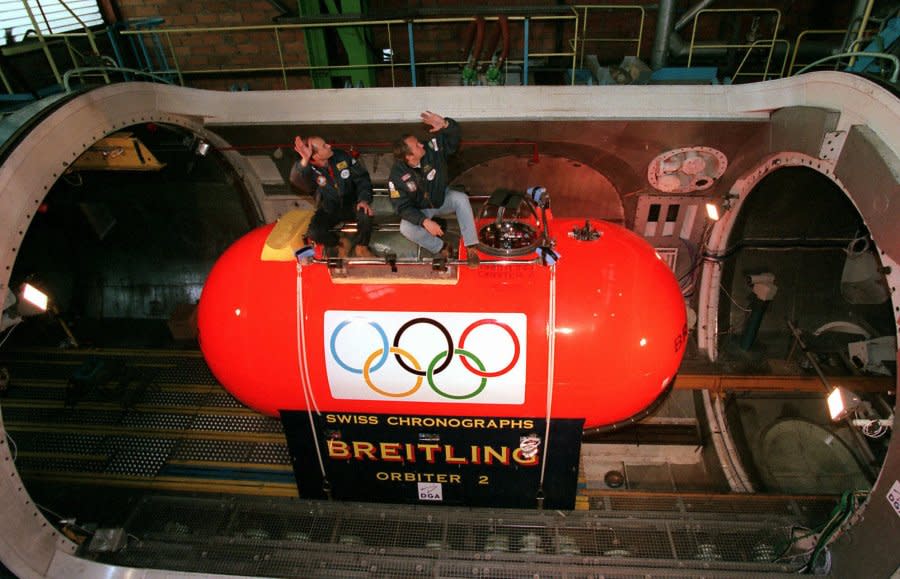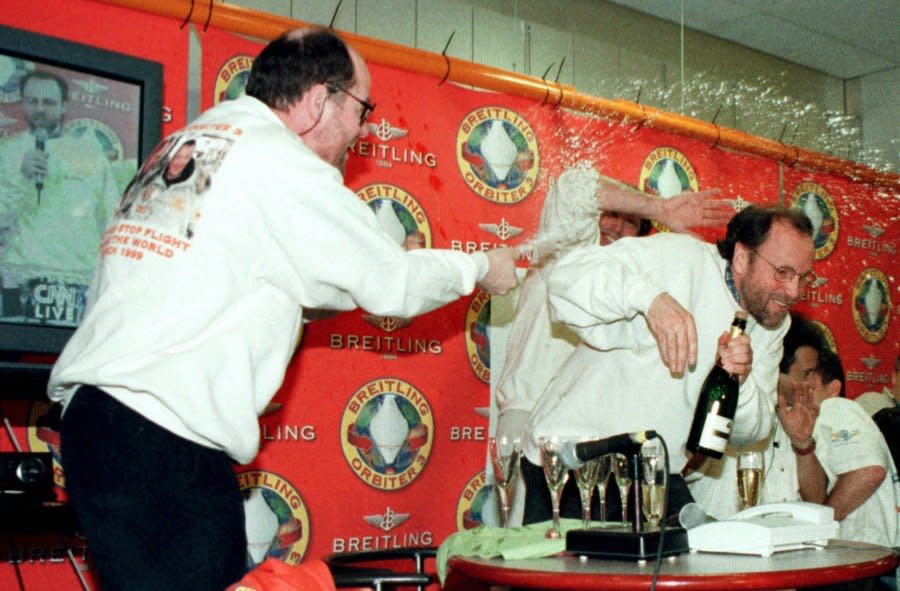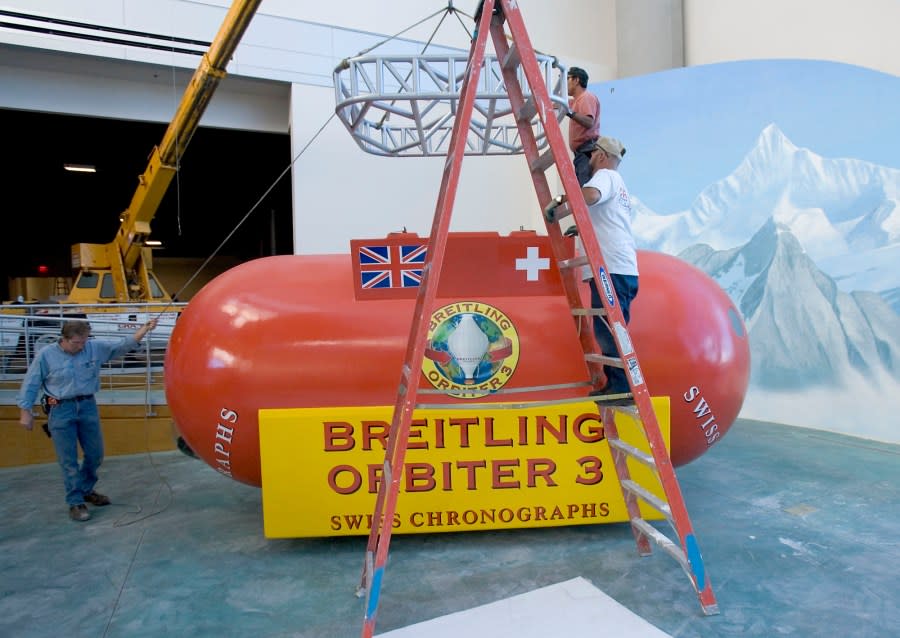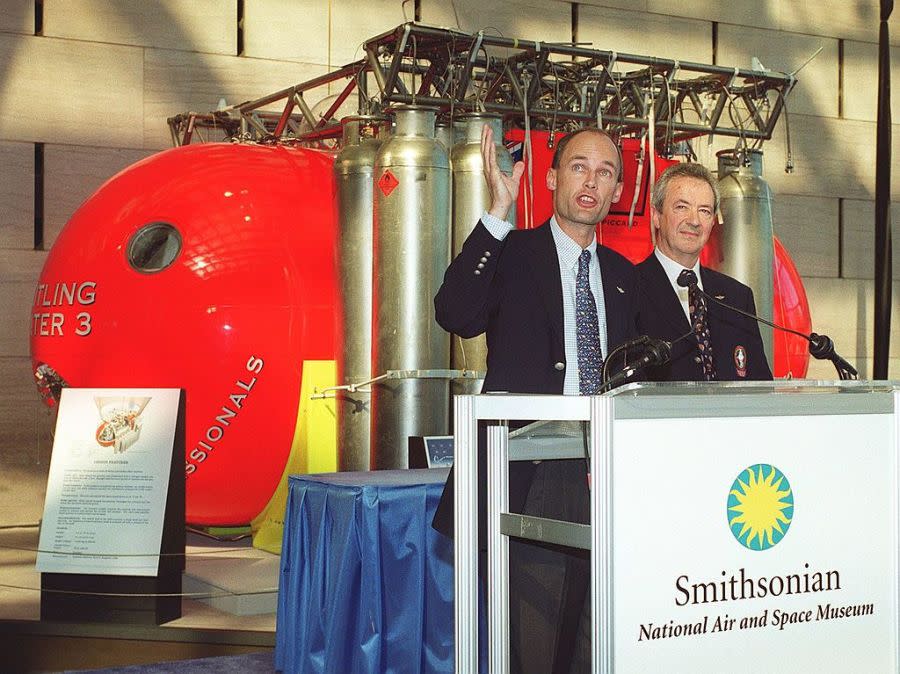On this date: Around the world by balloon

- Oops!Something went wrong.Please try again later.
(WHTM) — It sounds like the title of a Jules Verne novel from the 19th century, but it’s been described as the last great adventure of the 20th century-and it used a balloon design from the 18th century.
DAKHLA, EGYPT – MARCH 21: The Breitling Orbiter III balloon flies over the dunes of the desert of western Egypt 21 March 1999 before landing. Bertrand Piccard of Switzerland and Brian Jones of Britain landed safely, becoming the first to fly non-stop round the world in a hot-air balloon. (RUBEN SPRICH/AFP via Getty Images) Pilots Bertrand Piccard of Switzerland, left, and Wim Verstraeten of Belgium wave as they prepare to test the gondola of the Breitling Orbiter 2 balloon in an hyperbaric chamber outside Paris Wednesday Nov. 19, 1997. Four other balloons will join the Breitling Orbiter 2 in attempting the first circumnavigation of the world by balloon. No date has been set yet for the start of the race. (AP Photo/Michel Lipchitz) Flight director Alan Noble of Britain, left, sprays champagne at meteorologist Pierre Eckert and other team members in the control room for the Breitling Orbiter 3 balloon mission at Geneva airport Saturday, March 20, 1999. The party began after electronic equipment recorded the silvery Breitling Orbiter 3 floated past longitude 9 degrees west at 4:54 EST. After 19 days aloft, Bertrand Piccard and Brian Jones became the first men ever to fly round the world non-stop in a hot air balloon. (AP Photo/Keystone, Patrick Aviolat) Workers lower a rack on to a replica of the Breitling Orbiter 3, the first manned balloon to circumnavigate the globe, at the Anderson-Abruzzo International Balloon Museum in Albuquerque, N.M., Wednesday, Sept. 14, 2005. The museum, scheduled to open Oct. 1, coinciding with the Albuquerque’s annual Balloon Fiesta, will have interactive computer exhibits, an expansive display of ballooning memorabilia and displays of record-setting balloons. (AP Photo/Jake Schoellkopf) WASHINGTON, : Balloonists Bertrand Piccard (L) and Brian Jones participate in ceremonies 23 September, 1999 in which the gondola from their historic non-stop around-the-world flight will be put on display at the Smithsonian’s Air and Space Museum in Washington, DC. On 20 March,1999 the Breitling Orbiter 3 became the first balloon to achieve an around-the-world flight when Piccard and Jones flew 29,000 miles in 19 days, 21hours and 47 minutes.( CHRIS KLEPONIS/AFP via Getty Images)
On March 1, 1999, Swiss psychiatrist Bertrand Piccard (son of Jaques Piccard, grandson of Auguste Piccard) and English balloonist Brian Jones took off from the Swiss Alpine village of Château-d’Oex aboard the Breitling Orbiter 3. Their goal? Become the first people to circle the world in a balloon nonstop and without replenishing supplies, and win the Budweiser Cup, a one million dollar prize offered by Anheuser-Busch.
Get daily news, weather, breaking news and alerts straight to your inbox! Sign up for the abc27 newsletters here
In a way, this journey began 21 years earlier, when a three-man crew became the first balloonists to cross the Atlantic aboard the Double Eagle II. Over the next two decades balloon technology improved, and new distance records were set. The behavior of the jet stream, the bands of high winds in the upper atmosphere, were better understood; riding the streams to make better time figured in the planning of most long-distance ballooning. By the 1990s, circumnavigating the globe in a balloon was less a matter of if than when.
On this date: America’s first balloon flight
The Breitling Orbiter 3 used a Rozière balloon, a hybrid design built by the Cameron Balloon Company in England. It had two chambers, one for a lighter-than-air gas like helium or hydrogen, and another larger chamber for heated air. The hybrid design was the creation of Jean-François Pilâtre de Rozier, the first man to make a manned balloon flight in the 1700s. (Piccard and Jones’ balloon was named after Breitling SA, a Swiss precision watch company.) Propane to fuel six burners was stored in tanks on the outside of the gondola. Solar panels charged batteries which provided electricity for radios and GPS.
On this date: the deepest dive
After drifting southwest, Piccard and Jones picked up a jet stream over Mauritania. For the next 19 days, as their balloon traveled east, Piccard and Jones maintained a rotating shift, with one sleeping while the other manned the ship, and then eight hours working together. They traveled 25,361 miles, reaching altitudes of up to 38,507 feet, and speeds of up to 123 knots. They crossed the official “finish line” of the circumnavigation over Mauritania at 4:54 AM, EST on March 19.
Then they kept going.
On this date: First nonstop flight around the world
They hoped to finish their journey with a landing near the pyramids in Egypt, but high winds forced them to stop short of their target. They landed in the desert of western Egypt on March 21.
The Gondola of the Breitling Orbiter 3 was later donated to the Smithsonian Institute, and can now be seen at their Steven F. Udvar-Hazy Center at Washington Dulles International Airport.
To view a documentary about the flight, click here.
For the latest news, weather, sports, and streaming video, head to ABC27.




